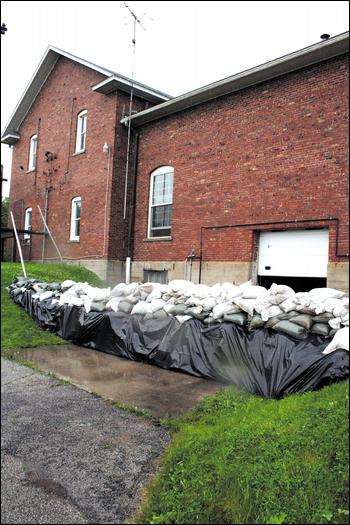
 |
|

|
Families should be prepared for all hazards that could affect their area. NOAA's National Weather Service, the Federal Emergency Management Agency, and the American Red Cross urge every family to develop a family disaster plan. Where will your family be when disaster strikes? They could be anywhere—at work, at school, or in the car. How will you find each other? Will you know if your children are safe? Disaster may force you to evacuate your neighborhood or confine you to your home. What would you do if basic services—water, gas, electricity, or telephones—were cut off? Follow these basic steps to develop a family disaster plan... Gather information about hazards. Meet with your family to create a plan. Implement your plan. ontact your local National Weather Service office, emergency management office, and American Red Cross chapter. Find out what type of disasters could occur andhow you should respond. Learn your community's warning signals and evacuation plans. Discuss the information you have gathered. Pick two places to meet: a spot outside your home for an emergency, such as fire, and a place away from your neighborhood in case you can't return home. Choose an out-of-state friend as your “family check-in contact” for everyone to call if the family gets separated. Discuss what you would do if advised to evacuate. (1) Post emergency telephone numbers by phones; (2) Install safety features in your house, such as smoke detectors and fire extinguishers; (3) Inspect your home for potential hazards (such as items that can move, fall, break, or catch fire) and correct them; (4) Have your family learn basic safety measures, such as CPR and first aid; how to use a fire extinguisher; and how and when to turn off water, gas, and electricity in your home; (5) Teach children how and when to call 911 or your local Emergency Medical Services number; (6) Keep enough supplies in your home to meet your needs for at least three days. Assemble a disaster supplies kit with items you may need in case of an evacuation. Store these supplies in sturdy, easy-to-carry containers, such as backpacks or duffle bags. Keep important family documents in a waterproof container. Keep a smaller disaster supplies kit in the trunk of your car. Practice and maintain your plan. Ask questions to make sure your family remembers meeting places, phone numbers, and safety rules. Conduct drills. Test your smoke detectors monthly and change the batteries two times each year. Test and recharge your fire extinguisher(s) according to manufacturer's instructions. Replace stored water and food every 6 months. Contact your local National Weather Service office, American Red Cross chapter, or local office of emergency management for a copy of “Your Family Disaster Plan” (L-191/ARC4466). A DISASTER SUPPLIES KIT SHOULD INCLUDE: A 3-day supply of water (one gallon per person per day) and food that won't spoil one change of clothing and footwear per person one blanket or sleeping bag per person a first aid kit, including prescription medicines emergency tools, including a battery-powered NOAA Weather Radio and a portable radio, flashlight, and plenty of extra batteries an extra set of car keys and a credit card or cash special items for infant, elderly, or disabled family members Develop a plan for you and your family at home, work, school, and when outdoors. The American Red Cross offers planning tips on their Internet site available on this system. Identify a safe place to take shelter. Information on how to build a Safe Room (shown in the photos below) in your home or school is available from the Federal Emergency Management Agency at Have frequent drills. Know the county/parish in which you live or visit. The National Weather Service issues severe weather warnings on a county or parish basis. Keep a highway map nearby to follow storm movement from weather bulletins. Have a NOAA Weather Radio with a warning alarm tone and battery back-up to receive warnings. www.redcross.org/services/disaster/keepsafe/ www.fema.gov/hazard/tornado/to_saferoom.shtm What YOU Can Do Before Severe Weather Strikes Be Prepared... It's Up to YOU! Each year, many people are killed or seriously injured by tornadoes and severe thunderstorms despite advance warning. Some did not hear the warning, while others heard the warning but did not believe it would happen to them. Following preparedness information, combined with timely severe weather watches and warnings, could save your life. Once you receive a warning or observe threatening skies, make the decision to seek shelter before the storm arrives. It could be the most important decision you will ever make. National Weather Service watches and warnings are also available on the Internet. Select your local National Weather Service office or go to Mahaska Health Partnership Fastcommand site. Listen to radio and television for weather information. Check the weather forecast before leaving for extended periods outdoors. Watch for signs of approaching storms. If severe weather threatens, check on people who are elderly, very young, or physically or mentally disabled. ~ ~ ~ ~ ~ ~ ~ ~ ~ ~ ~ ~ ~ ~ ~ ~ ~ ~ ~ ~ ~ ~ ~ ~ ~ ~ ~ ~ ~ ~ ~ ~ ~ ~ ~ ~ ~ |
|
|||||||||||||||||||||
| Mahaska Health Partnership, 1229 C Avenue East, Oskaloosa, IA 52577, (641) 673-3431 | |||||||||||||||||||||||
| ©2026 FastHealth Corporation Terms Privacy | US Patent Numbers 7,720,998 B2, 7,836,207 |